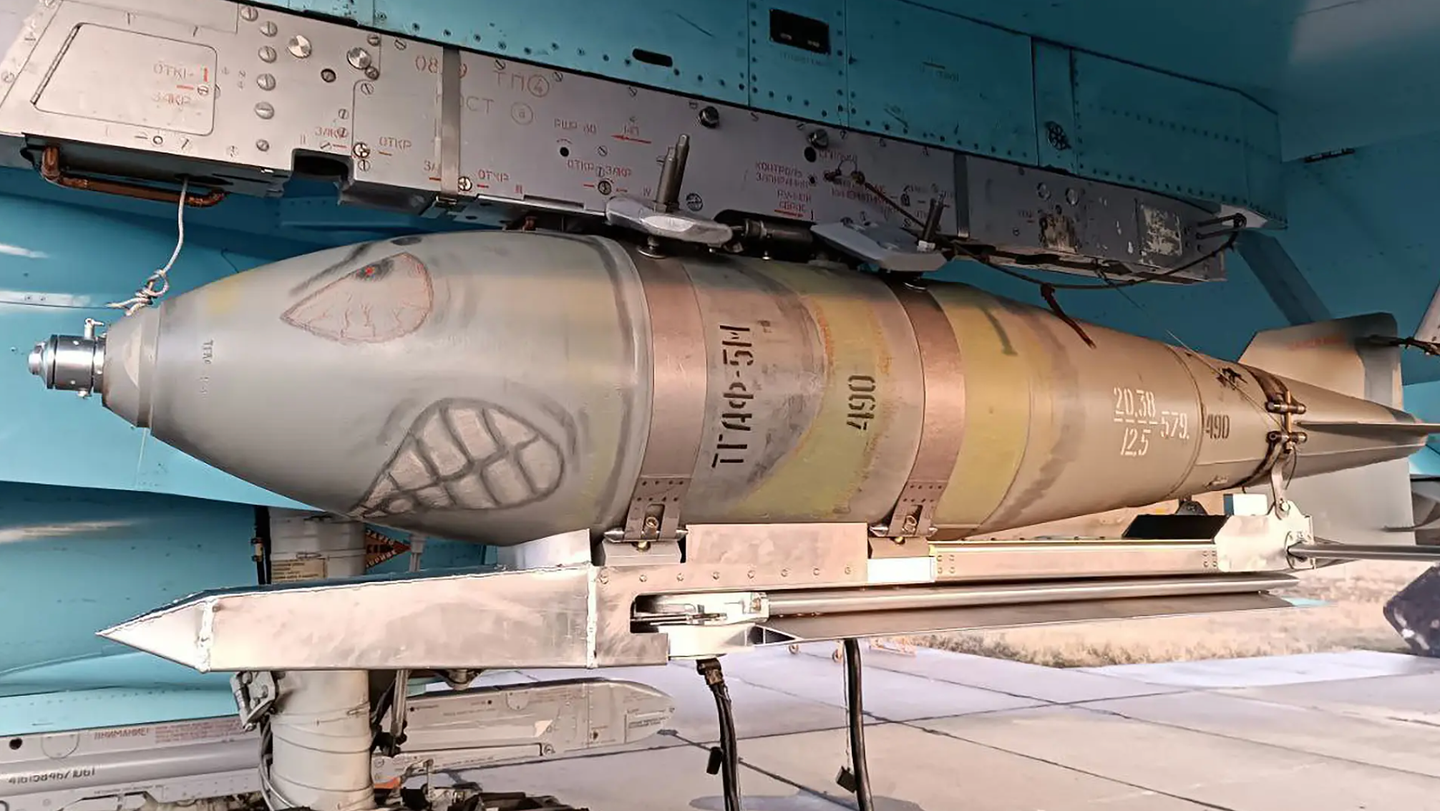After several months of trial and error, the Russian Aerospace Forces (VKS) fired its first-ever UMPC FAB-1500 M54 high-explosive fragmentation bombs on a target. The bomb reportedly hit the designated mark with accuracy.
This was reported by a former military pilot and Russian military aviation blogger ‘Fighterbomber’ on his Telegram channel.
In essence, these bombs are stand-off weapons with flight controls that enable them to use a gliding flight path onto a target at a greater distance. This allows the carrier of these bombs to fire them without entering hostile airspace.
Some reports doing rounds on social media suggested that due to the new design of the glider incorporated by engineers, the range of bomb delivery has been significantly increased compared to similar, lower-yield munitions already in use with the VKS.
According to Fighterbomber, the designers, for some reason, could not manage to increase the planning and correction modules (UMPC), which are used on FAB-250 and FAB-500, and attach them to the lorry.
Everything had to be built from scratch, including a new airframe and mechanisms. “Everything is solid, but everything is new,” the blogger wrote.
With a declared accuracy of five meters, the bomb creates an explosion crater that is fifteen meters in diameter. In addition, the area that is affected by firing this munition is about two square kilometers.
The explosives in this bomb are under 700 kilograms. This bomb, however, could be carried by Su-34 and Su-35 fighters of the VKS, which have been extensively deployed in the ongoing Ukraine war.
‼️🇷🇺💥 Russian Army Deploys FAB-1500 with UPMK for the First Time, Reports Fighterbomber
▪️ The range of bomb delivery has been significantly increased (compared to similar, lower-yield munitions) thanks to the new glider design.
▪️ With an advertised accuracy of 5 meters, the… pic.twitter.com/lRTr0qHr4P
— Zlatti71 (@djuric_zlatko) September 5, 2023
The bomb was reportedly fired by the Su-34 Fullback, which is a bomber fighter that can fire an array of cutting-edge munitions, including several long-range munitions, as well as the Kinzhal hypersonic missiles as recently announced by the Russian MoD.
According to claims made on social media, the fighter could carry at least two of the UMPC FAB-1500 M54 bombs, which would be increased to three in the future. With three such bombs, the Su-34 could fire one at a time or fire three bombs simultaneously aimed at three different targets, according to Fighterbomber’s Telegram post.

Moreover, it was also reported that although much work remains to be done on the new munition, with several upgrades also needed, the successful combat deployment had already begun. The blogger also highlighted that the Ukrainians have no defense against the FAB-type glide bombs.
The bomb’s maximum glide range is much greater than existing, lighter bombs, like the FAB-500 M62. The bomb’s production is anticipated to increase now that it has been operationally tested and proven.

Attaching an image of the bomb, the military blogger wrote on his channel that the greatness and lethality of the new munition could be assessed in the photo compared to the average Russian glide bombs, which by no means are small.
In addition to this, it was noted that while using the FAB-1500 in combat was uncommon, the bomb had been deployed by Russia in a few instances. “I think within a month, the Russian state arms manufacturing industry could arrange their production for the requisite volumes. Since such bombs of more modest calibers fly in all directions today, it wouldn’t be a task to produce and introduce this brand-new bomb into the battlefield.”
Russia’s Formidable Glide Bomb
Although signs that Russia used some hurriedly developed glide bombs in its conflict with Ukraine began to emerge at the beginning of this year. For many months, there was little information available.
It was only a couple of months ago that some details started to emerge about the UMPK, or Unifitsirovannyi Modul Planirovaniya i Korrektsii, a unified gliding and correction module.
The first reports of Russia using all-purpose bombs equipped with wing kits to hit targets in Ukraine surfaced on January 4, 2023. The Fighterbomber channel on Telegram broke the news of the development. Then, on February 20, the same source stated that the development of UMPK stand-off bomb kits had been ongoing “for four months” and that “hundreds of UMPK bombs had already been dropped.”
Later, in April, Ukrainian Air Force spokesperson Yuriy Ihnat said that the Russians were dropping “up to 20 gliding bombs a day.” Ihnat continued: “They launch them from Su-35 Flanker and Su-34 Fullback aircraft, which do not enter our air defense zone.”

Since then, Ukrainian officials have spoken on the issue numerous times, describing how tough it is to intercept these missiles because they are “almost impossible to shoot down.” Moreover, a communiqué released by Russia on May 8, 2023, stated that a Su-34 fighter-bomber with UMPK module bombs struck a location of foreign mercenaries near the village of Ivanovka near Kharkiv.
The wing kits enable Russian aircraft to perform covert assaults on locations they would otherwise be unable to reach directly because of Ukraine’s constantly improving anti-aircraft defenses.
These bombs enable the VKS to launch seamless stand-off attacks from the safety of its airspace, which would otherwise require it to fire considerably more expensive and complicated stand-off weaponry. These bombs make those attacks easier, given that the protracted war effort has put significant pressure on Russia’s limited supply of these weapons.
Russian engineers have created a planning and correction module for the FAB-1500 M54.
The declared accuracy is 5 meters, the explosion crater is fifteen meters in diameter, and the affected area is more than two square kilometers.
Can be used with Su-34 and Su-35 pic.twitter.com/nwuwUHTEfa— senore_amore (@SenoreAmore) September 5, 2023
The flying UPABs and FABs, which are approximate replicas of the American-made JDAM-ER glide bombs used by Ukraine, are probably unrealistic. The GLONASS satellite navigation system, which is claimed to be less accurate than the American GPS, provides the coordinates the Russian weapons use to focus their fire.
In particular, the handcrafted FAB glide bombs are inexpensive. Potentially just costing a few tens of thousands of dollars each. More jets are dropping their bombs from outside the range of the most heavily fortified Ukrainian air defenses as the use of glide bombs expands in the Russian air force.
- Contact the author at sakshi.tiwari9555 (at) gmail.com
- Follow EurAsian Times on Google News




